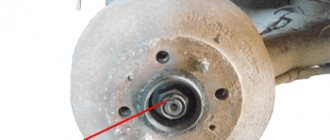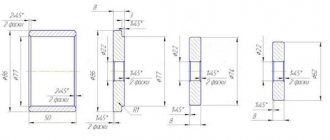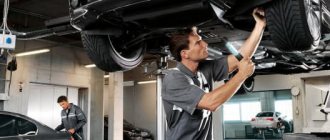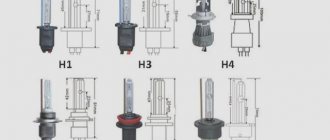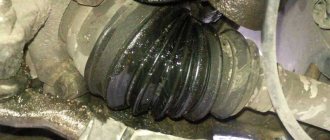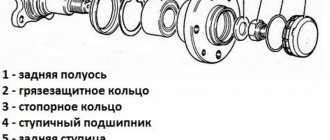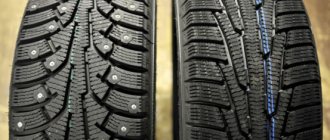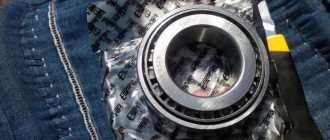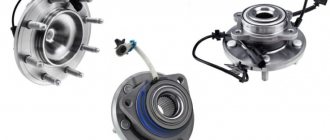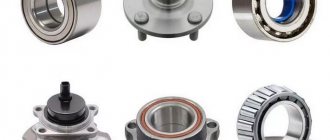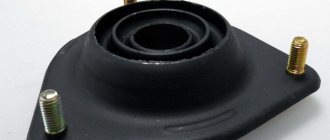Over time, as a result of vehicle operation, various noises appear when driving, which indicate wear of one or another part. Replacing it in a timely manner solves the problem in the best possible way.
The main thing is to identify the worn part in time. Experienced drivers can do this by listening to the sound. On the other hand, this is quite difficult to do, since many other components and suspension parts also make noise when worn. Therefore, here you need to stick to proven methods.
Where is the wheel bearing located and why is it needed?
In normal mode, this part operates silently. If the hub bearing is humming , then there is a problem in the interface unit. To understand how important it is to monitor the condition of this structural element, let’s understand its functions and purpose.
In short, this part connects the wheel and suspension. It is located in the center of the wheel rim and is put on the axle shaft. The main function of the device is to ensure free rotation of the wheel and maintain its position in a vertical plane.
If the bearing is worn out, play appears and the rotation of the wheel becomes uneven. The car's handling deteriorates, but that's just the beginning. If a worn part is not replaced in time, the wheel may jam while driving. It's good if the speed is low.
Obviously, as soon as the wheel bearing begins to hum , it needs to be replaced.
Don't rely on "maybe". Especially on the fast track. When a wheel gets stuck, the car can be thrown into the oncoming lane, creating the danger of a head-on collision with traffic moving there.
Main symptoms of wheel bearing failure
The first deviation by which a malfunction is determined is extraneous noise. How does a wheel bearing hum when problems arise? This sound can be quite loud and appears at speeds of about 50 km/h. You can compare it with the noise of an accelerating train or an airplane preparing to take off. At advanced stages, crunching and metallic grinding are added to the hum.
It is important not to confuse this sound with the noise of a faulty transmission. The gearbox or gearbox is noisy when accelerating or releasing the gas, the hub bearing is humming
in any driving mode. We are, of course, talking about faulty units. A working car runs silently.
Another sign of a problem is vibration transmitted to the steering wheel and body. This sign cannot be ignored. If the car shakes, and the steering wheel constantly shakes and breaks out of your hands, immediately contact a car repair shop.
Another signal indicating problems is incorrect behavior of the machine. If the car constantly pulls to the side, it means that one of the wheels is jammed. This may indicate a problem with the hub assembly.
Signs of a broken wheel bearing
A reason to check your vehicle's wheel bearing may be one or more of the following symptoms:
- The appearance of a hum (similar to a “dry” crunch) from the wheel. As a rule, a hum occurs when the car exceeds a certain speed (usually this value is about 60...70 km/h). The hum intensifies when the car turns, especially at high speed.
- Often, along with the hum, vibration occurs not only in the steering wheel, but in the entire car (due to beating of the bearing), which is felt when driving, especially on a smooth road.
- Overheating of the wheel rim during prolonged driving of the vehicle. In some cases, the brake caliper overheats to the point where the brake fluid can boil.
- Wheel jamming. For the driver, this is expressed in such a way that when driving in a straight line, the car seems to be “pulled” to the side. This is caused by the fact that the problem bearing slightly slows down the wheel associated with it. The symptoms are similar to those that occur with an incorrectly adjusted wheel alignment. This behavior is already very dangerous, since if the wheel bearing jams, it can break the CV joint , and at speed the disk will cut the tire!
How to determine which bearing is humming
A passenger car has four wheels, and it also has four hubs. Problems can occur in any of them. The front ones fail more often. How to determine which wheel bearing is humming? By ear and hands. Let's take a closer look.
First you need to determine which axle the problem is on: front or rear. You need to listen carefully to the sounds of a moving car. In most cases, it is possible to figure out: the front bearing or an analogue on part of the rear axle shaft is humming.
to identify a humming bearing from the front. It is enough to move like a snake - turning in different directions. If the noise becomes more pronounced when turning to the right, you need to change the part on the left; when it makes noise when turning left, the problem is in the hub on the right.
If it was not possible to “calculate” by ear which wheel bearing is humming , move on to the next stage. Using a jack, we lift each wheel one at a time and try to swing the disk laterally. If there is significant play, there is definitely a problem.
Important! The cause of wheel play may be broken ball pins. You can exclude this reason from the list by asking an assistant to press the brake pedal while checking. If the play disappears, the problem is definitely in the bearing. When McPherson suspension is checked, a little play is acceptable.
Spin the wheel with your hands and listen: a hum can be heard in faulty hubs. The more the wheel rotates, the louder the problem part makes noise. In a similar way, technicians determine that the rear or front axle bearing is humming.
Touch the steering knuckle at the hub mounting point: when a wheel with a faulty bearing rotates, a beating is felt and a hum is heard. If everything is in order with the chassis, there are no vibrations or extraneous sounds.
Method number 2
How to check the rear wheel bearing and the front one? It is not necessary to look for a flat area for this. You can put your car on a lift. Next, you should grab the top and bottom of the tire with your hands and shake it a little in a horizontal or vertical plane. Any backlash is excluded. If you see that the wheel is wobbling with a gap, it means that the wheel bearing has become unusable. Note that a slight play is allowed on the rear wheels. But its magnitude barely exceeds hundredths of a degree. On the front axle, play is not allowed at all.
If you can't use a lift, no problem. Use a jack. But the disadvantage of this method is that you will have to hang all four wheels separately (since the bearing can hum from different directions). It will take a little longer. But these are not all the methods of how to check a wheel bearing. There is another proven method.
Reasons why a wheel bearing hums
There are several reasons why a front or rear wheel bearing .
The most obvious:
- water and dirt under the seals;
- wear products in the workspace;
- insufficient amount of lubricant;
- mechanical damage as a result of extreme driving;
- incorrect installation when replacing;
- inaccurately set camber/toe;
- brake system malfunction.
Often a wheel bearing becomes unusable due to changes made to the design unplanned by the developer. This is the so-called tuning - installing disks of increased diameter or width.
What to do with a humming bearing?
The first question that arises after detecting a malfunction is whether it is possible to continue driving. Motorists are forced to postpone repairs by various circumstances: an urgent trip, lack of free time for replacement and a simple lack of funds. Some individuals hope for the Russian “maybe” and continue to operate the car to the last degree of wear and tear.
The final failure of the bearing of any of the front wheels is dangerous primarily for the passengers of the car. If the separator falls apart, a huge play will appear in the hub, the wheel will begin to wobble and the car will lose control. It is difficult to predict how this will end when driving at high speed. The destruction of the rear bearing assembly is not so critical - the malfunction will simply immobilize the car.
Such breakdowns often lead to the separation of the front or rear wheel, which flies further due to inertia. There is enough video material on the Internet showing where detached car ramps end up - in oncoming traffic, pedestrians, and so on. If the owner of the wheel remains unharmed in an accident, it can cause damage and injury to others.
What to do when a bearing hums:
- Perform the diagnosis yourself without delaying it. Find out exactly which side the problem part is on.
- The front wheel bearing, which produces a characteristic noise, is strongly recommended to be replaced immediately.
- If you need to get to the garage after discovering a problem, drive slowly and carefully. Stopping periodically, check the degree of heating of the hub and allow it to cool down.
- There is also no need to delay with a faulty rear mechanism. Allow time to replace the part and, if necessary, find funds or park the car until repairs are made.
It is considered incorrect to ask how long you can drive with a humming wheel bearing. No auto mechanic in his right mind will give a definite answer, since such driving is akin to a lottery. Practical experience shows that most drivers do not want to take risks and take the situation to an extreme, and therefore change the non-working part in a timely manner.
How to extend the life of a wheel bearing
Avoid deep puddles to prevent water and dirt from getting under the seals. Reduce your speed on uneven roads - strong impacts can directly cause damage to the wheel bearing. Often problems in this unit arise due to faulty shock absorbers that are destroyed during aggressive driving on bad roads.
Trust the replacement and repair of wheel bearings to trusted specialists at reputable car repair shops. If you install this part even with a slight misalignment, problems will inevitably arise and you will have to pay an even higher price. Damage to the protective seals should also be avoided.
What happens if you don't change the bearing when it hums?
If an unpleasant, suspicious hum appears when reaching a certain speed and/or entering turns, it is necessary to check the hub as soon as possible. Operating a car with a broken wheel bearing is not only harmful to the car, but also dangerous!
What happens if the wheel bearing jams? Clearly
So, if you do not change a failed wheel bearing in time, this can lead to (or simultaneously several) emergency situations:
- Additional load (vibration) on the chassis of the vehicle and its steering. This leads to a decrease in the service life of their individual parts and assemblies.
- The engine thrust and its efficiency decrease, which can also lead to an increase in fuel consumption.
- Overheating of the brake assembly may cause the brake fluid to boil. This will lead to partial and even complete failure of the braking system!
- When turning, the wheel may simply “lie down”, which will lead to loss of control over the car. At speed this can be fatal!
- If the wear is critical, the bearing may jam, causing the wheel to stop. And if such a situation occurs while driving, it can cause a significant accident!
If for some reason at the moment you do not have the opportunity to urgently change the hub bearing, then when the hub begins to hum, you can drive at low speeds, up to approximately 40...50 km/h, and drive no more than 1000 km. It is highly not recommended to accelerate faster and ride longer!
